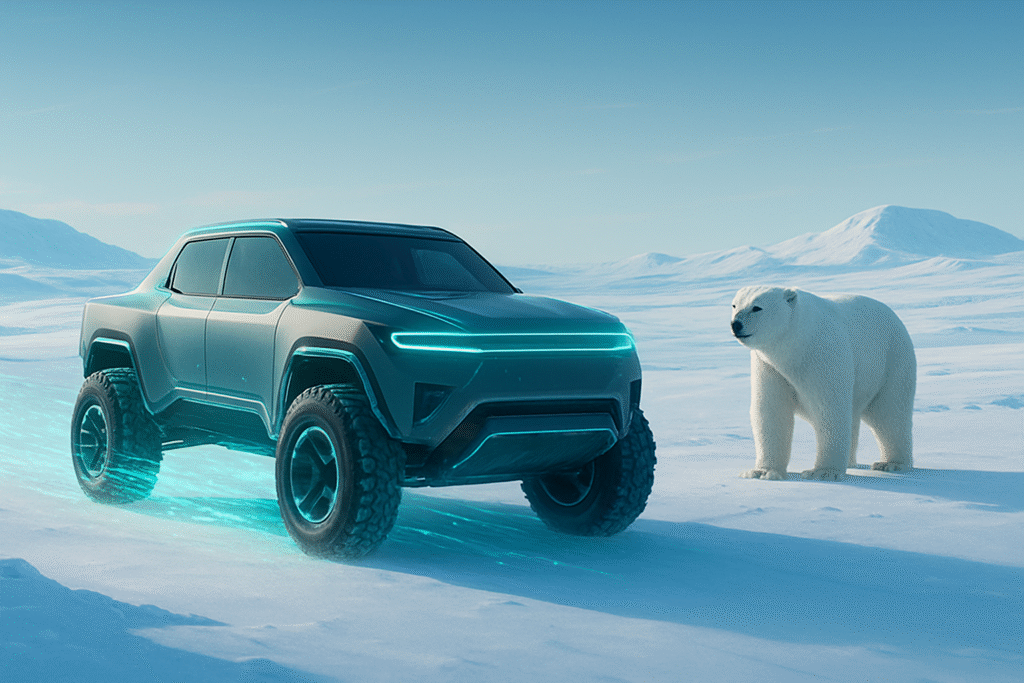
In a groundbreaking stride for environmental stewardship and sustainable tourism, Canada is deploying a fleet of cutting-edge electric Tundra Buggies to safeguard its iconic polar bear populations. This innovative technological shift, spearheaded by adventure travel operators in Churchill, Manitoba—the self-proclaimed "Polar Bear Capital of the World"—marks a pivotal moment in conservation efforts, directly addressing climate change and minimizing human impact in fragile Arctic ecosystems. By replacing traditional diesel engines with silent, zero-emission electric powertrains, these specialized vehicles offer a new paradigm for wildlife observation, promising a less intrusive and more impactful experience for both bears and visitors.
The immediate significance of this transition is multifaceted. Each electric Tundra Buggy put into operation immediately reduces the localized carbon footprint of tourism activities, contributing to a tangible decrease in greenhouse gas (GHG) emissions that are accelerating Arctic sea ice melt—the primary threat to polar bear survival. Furthermore, the virtually silent operation of these electric vehicles drastically minimizes noise pollution, allowing for a more authentic and stress-free environment for wildlife, while also enhancing the educational and research platforms vital for understanding and protecting these magnificent creatures. This initiative serves as a powerful proof of concept for green technology's viability even in the planet's most extreme conditions, inspiring a proactive approach to environmental challenges.
Engineering a Quieter Future: The Technical Prowess of Electric Tundra Buggies
The transformation of diesel-powered Tundra Buggies into their electric counterparts is a testament to sophisticated engineering tailored for the subarctic's demanding environment. These custom-built, large-capacity (typically 40-passenger) off-road vehicles are now propelled by repurposed batteries, initially sourced from electric buses manufactured by New Flyer Industries (NASDAQ: NFYEF). The battery system boasts a total energy capacity of 200 kWh, organized into four independent banks, operating at a nominal 622 VDC. This redundant design ensures operational continuity, allowing the vehicle to function even if one battery bank is compromised. Charging primarily relies on Manitoba's 100% renewable hydroelectric grid, further solidifying their eco-friendly credentials.
The conversion process involves a complete overhaul of the vehicle's propulsion system. The original 7.6 L Navistar DT466 diesel engine and Allison transmission are replaced by an all-electric system featuring one motor per axle, each continuously rated at 100 kW (134 HP) with peak outputs of 170 kW (228 HP). This delivers significantly increased torque—up to 1,320 Nm at 0 RPM—compared to the diesel versions. The chassis and suspension are entirely new, incorporating a 5-link suspension system with 8 inches of travel for enhanced articulation and passenger comfort. Advanced steering modes, including front-wheel, rear-wheel, crab, and four-wheel steer, dramatically improve maneuverability on the rugged tundra. The operator interface has also been modernized, replacing traditional controls with an LCD display and custom software integrating propulsion, hydraulic steering, and battery management.
Operating electric vehicles in temperatures as low as -50°C (-58°F) presents formidable engineering challenges. Battery efficiency, capacity, and charging speed are all significantly impacted by extreme cold. To mitigate this, specialized thermal management systems are crucial, though some early models still rely on a small kerosene heater to maintain battery warmth when not in use, indicating ongoing development. Component durability, ensuring electronics and mechanical parts withstand drastic temperature fluctuations, is also paramount. Despite these hurdles, the successful deployment and ongoing expansion of the electric Tundra Buggy fleet demonstrate the remarkable progress in cold-weather EV technology, drawing positive reactions from the conservation community and industry experts who laud the initiative as a significant step towards sustainable tourism and a "made-in-Manitoba story" of clean tech innovation.
Corporate Footprints: Beneficiaries and Competitive Edge
The pioneering effort to electrify Tundra Buggies involves a collaborative ecosystem of companies, each playing a crucial role in advancing sustainable tourism and technology. At the forefront is Frontiers North Adventures, a private Canadian-based, family-owned, and Certified B Corp adventure travel operator. As the initiator and primary operator of the EV Tundra Buggy project, Frontiers North is committed to converting its entire fleet of 12 vehicles to electric by the end of the decade, gaining a significant first-mover advantage in the eco-tourism sector. Their strategic positioning as a leader in sustainable Arctic eco-tourism attracts environmentally conscious travelers and fosters strong brand loyalty.
Several key partners contribute to the technical success. Red River College Polytechnic (RRC Polytech), through its Vehicle Technology & Energy Centre (VTEC), provided crucial technical validation and expertise. Noble Northern, a private company, is actively involved in the conversion process and building new EV Tundra Buggies. Specialized component providers like JEM Technical, which developed custom control software, and CrossControl and HydraForce, which supplied the touchscreen display and primary controller respectively, are establishing expertise in a niche market for heavy-duty EV conversions in extreme conditions. Their involvement enhances their reputation as providers of robust, green engineering solutions.
The most notable public company benefiting from this development is NFI Group (NASDAQ: NFYEF), the parent company of New Flyer Industries. New Flyer Industries, a leading electric bus manufacturer, donated repurposed batteries for the initial Tundra Buggy conversions. While not a core business, this contribution showcases NFI Group's commitment to sustainable technologies and the adaptability of their battery technology, indirectly reinforcing their market position in the broader electric vehicle sector. The success of this project could inspire other eco-tourism operators globally to adopt similar electric vehicle solutions, creating a ripple effect that benefits technology providers specializing in rugged, off-road EV conversions and sustainable charging infrastructure.
A Broader Canvas: Impact, Concerns, and Conservation Milestones
The integration of electric Tundra Buggies into Arctic tourism extends far beyond local operational benefits, fitting into the broader global landscape of environmental conservation and sustainable tourism. By significantly reducing greenhouse gas emissions—estimated at 15.74 tonnes annually per electric buggy, with a projected fleet-wide reduction of over 3,600 tonnes of CO2 over 25 years—these vehicles directly contribute to mitigating climate change, the existential threat to polar bears and their sea ice habitat. The minimized noise pollution also creates a less intrusive presence in the delicate Arctic ecosystem, allowing wildlife to behave more naturally and enhancing the immersive experience for tourists, who can now hear the sounds of the tundra rather than a diesel engine.
The wider impacts touch upon both Arctic ecosystems and, indirectly, Indigenous communities. A healthier, less polluted Arctic environment directly benefits the region's diverse wildlife and the Indigenous peoples whose cultures and livelihoods are deeply intertwined with the land. While direct engagement with Indigenous communities regarding the buggies isn't extensively detailed, the commitment to "stewardship, and positively contributing to our communities and environments" by operators like Frontiers North Adventures aligns with broader goals of reconciliation and sustainable development. The Tundra Buggies also serve as vital research platforms for organizations like Polar Bears International, hosting scientists and live webcams, thereby aiding global awareness and conservation research.
However, the technology is not without its limitations and concerns. Operating electric vehicles in extreme cold poses ongoing challenges for battery performance, range, and charging efficiency, necessitating specialized thermal management. The high initial investment and conversion costs can be a barrier for wider adoption, though projected long-term savings in fuel and maintenance may offset this. Furthermore, while crucial locally, the electric Tundra Buggy alone cannot solve the overarching climate crisis, which requires broader systemic changes. Compared to other conservation technology milestones like GPS tracking, remote sensing, or drone surveillance, electric Tundra Buggies offer a unique contribution: they don't just monitor environmental impact but actively reduce it at the source, transforming the very mode of human interaction with nature to be more harmonious and less disruptive.
The Horizon: Future Developments and Expert Predictions
The journey for electric Tundra Buggies and similar conservation technologies is just beginning, with significant near-term and long-term developments anticipated. Frontiers North Adventures is steadily progressing towards its goal of a fully electric fleet by the end of the decade, with continuous improvements expected in battery performance and cold-weather resilience. Beyond the Tundra Buggies, the success of this initiative is likely to accelerate the adoption of electric safari vehicles in Africa and electric boats for water-based wildlife viewing in other sensitive ecosystems, expanding the reach of silent, zero-emission tourism.
Future advancements in battery technology will be crucial, focusing on enhanced thermoregulatory designs, new chemistries like solid-state or sodium-ion batteries, and methods for ultra-fast charging even in sub-zero temperatures. Experts predict increasingly robust and efficient battery thermal management systems (BTMS) will become standard. Furthermore, the integration of AI and robotics will revolutionize conservation, with autonomous drones equipped with AI-powered thermal cameras for anti-poaching and wildlife monitoring, and AI systems analyzing data from underwater drones for ocean health.
Despite the promising outlook, challenges remain for wider adoption. The high initial cost of specialized electric vehicles and the need for robust charging infrastructure in remote areas are significant hurdles. The availability of skilled technicians for maintenance and repair in isolated regions also needs to be addressed. Experts predict a continued and accelerated shift towards electric and autonomous technologies, with a strong emphasis on decentralized and renewable charging solutions, such as off-grid solar and wind-powered stations. This synergy between technology and conservation will empower conservationists to manage resources more effectively, respond proactively to threats, and gather more comprehensive data, ultimately leading to a more sustainable and harmonious coexistence with nature.
A New Era of Conservation: Wrapping Up the Electric Revolution
The advent of electric Tundra Buggies represents a transformative moment in the history of environmental conservation and sustainable tourism. By leveraging advanced electric vehicle technology, these silent guardians are directly combating climate change, reducing localized pollution, and fostering a more respectful interaction with the Arctic's delicate ecosystem and its iconic polar bears. The initiative by Frontiers North Adventures, supported by a network of innovative partners including NFI Group (NASDAQ: NFYEF), showcases the power of collaboration and technological ingenuity in addressing pressing environmental challenges.
The key takeaways from this development are clear: electric vehicles offer a viable and impactful solution for reducing the ecological footprint of human activities in sensitive natural areas, even in extreme climates. The enhanced guest experience, coupled with tangible environmental benefits, sets a new benchmark for responsible tourism. While challenges related to cost, infrastructure, and extreme weather performance persist, the rapid pace of innovation in battery technology and renewable energy solutions suggests these hurdles will continue to be overcome.
Looking ahead, the success of electric Tundra Buggies will undoubtedly inspire similar electrification efforts across various conservation and eco-tourism sectors globally. The coming weeks and months will likely see further progress in Frontiers North Adventures' fleet conversion, ongoing research into cold-weather EV performance, and increased interest from other operators in adopting similar sustainable technologies. This marks not just a technological upgrade, but a profound shift in our approach to nature—moving towards a future where human presence in the wild is characterized by minimal impact and maximum respect.
This content is intended for informational purposes only and represents analysis of current AI developments.
TokenRing AI delivers enterprise-grade solutions for multi-agent AI workflow orchestration, AI-powered development tools, and seamless remote collaboration platforms.
For more information, visit https://www.tokenring.ai/.







